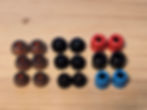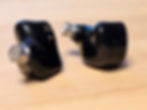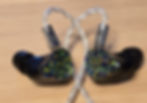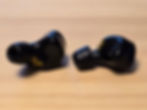Pula PA02 - Is There OR Isn't There A Difference? - Honest Audiophile Impressions
- dbstechtalk
- Aug 14, 2024
- 9 min read

Much discussion has arisen regarding whether the Pula PA02 and Myer Audio CKLVX D41 are identical devices with just a different appearance and branding, or if they also differ in sound. Today, we will explore this question and provide my honest audiophile impressions on whether they offer different sound experiences.

I bought the Pula PA02 using my personal funds as well as contributions from my Patreon and YouTube followers. The Pula PA02 is available for purchase here through these non-affiliated links.
Purchase:
Amazon:
Sonicfoam SF1:
The Pula PA02 will set you back $190 from your bank account. The PA02 is a hybrid model featuring a total of five drivers, comprising a three-way crossover, a 10mm dynamic driver, and four balanced armatures. It has an impedance of 36Ω, a sensitivity of 111dB, and a frequency response range from 20Hz to 20kHz.
Box/Contents:



The Pula PA02 is packaged in a compact box with a celestial, starry design, featuring a couple of white stickers displaying branding and specifications.

Removing the outer sleeve reveals a plain black box. Taking off the lid of the black box exposes a foam insert containing the PA02 placed at the top, along with a blue carrying case.


The cylindrical carrying case seems to be crafted from leather, with a snug gold zipper sealing the lid. Inside, it features a soft blue velvet lining and offers ample space for the Pula PA02 to securely rest.


I am confident that the carrying case will effectively protect the PA02. While it may be too large for a pocket, it will easily fit into a bag.

Pula includes two types of tips, one made of silicone and the other of foam.
The foam set includes S/M/L sizes, while the silicone set contains two varieties of tips in S/M/L sizes each: black narrow bore and grey medium bore tips.
Later in the impressions, we will address the sonic variances of the tips.
Build/Design:

Shifting focus to the Pula PA02, they're appearance is fitting for a $190 IEM.




The faceplates feature an appealing blue and green speckled design with the word "Pula" in the center. The shells are slightly larger in size.






The ergonomic back of the shell includes a small wing, a sharp angle, and a nozzle length slightly longer than average.
The construction of the Pula PA02 appears to be of high quality considering its price range; I am confident that it will not break easily if well taken care of.
Comfort/Isolation:

The Pula PA02 provides a satisfactory level of comfort. The ergonomic shell fits snugly in my ear, despite its larger size.


However, the angle of the nozzle can lead to some discomfort after extended use. I usually wear the PA02 for about an hour before needing a short break or readjustment.


I've found that using foam tips enhances comfort significantly.
The noise isolation is commendable, particularly when using foam tips, blocking approximately 66% of external noises. The only noticeable sounds that were somewhat muted included vacuum cleaners, coffee grinders, and loud vehicles, I had to remove the earphones to engage in a conversation.
Cable:

The provided cable is not particularly remarkable, but it effectively fulfills its purpose. It is lightweight, slim, and well-managed, with the ear hooks offering adequate tension.

It is available with different terminations; I opted for the 4.4mm balanced version. The connection is made via a 2-pin to the shell.
Tips:
Let's discuss the tips provided for a moment. Pula offers various options mentioned in the box contents section. Although each tip has a slightly different presentation, I found all of them to be somewhat uncomfortable.

The black silicone tips provided a warm and intimate sound with a touch more depth in the stage, but they felt a bit stuffy overall.

The grey silicone tips were wider but lacked depth, offering a bit more air and space.

The stock foam tips were the most balanced and cohesive, similar in width to the grey tips but with better depth. However, the stock foam tips were not the most comfortable, as even the smallest blue one expanded too much in my ear, causing discomfort.

I discovered that the small Sonicfoam SF1 tips were more comfortable and provided a similar sound to the stock foams.
Source Pairing:
The Pula PA02, with an impedance of 36Ω and sensitivity of 111dB, is relatively easy to power. It shows some improvement when paired with increased power and better sources. I found that all my dongles, DAPs, and desktop equipment could drive the PA02 to high volumes without any problems. However, providing it with a bit more power from a quality source allowed the PA02 to reach its maximum potential. A few standout pairings were the Moondrop Dawn 4.4, AFUL Snowy Night, DUNU DCT480, Hiby R5 gen2, Fiio K11 and Mytek Liberty DAC ii.
Some of the Gear Used in Testing:
Moondrop Dawn 4.4
DUNU DCT480
Hiby FC4
Fosi Audio DS2
Rose Technics RS9039
Fiio KA17
Aune Yuki
AFUL Snowy NightHiby FC3
Fiio K11
Fiio K19 Geshelli Labs J2
Geshelli Labs Erish 3
Fiio K9 AKM
Mytek Liberty DAC ii
Mytek Liberty THX HPAHiby R5 Gen 2
My Terms & Definitions:https://www.thehonestaudiophile.com/post/the-honest-audiophile-s-terms-and-definitions-guide
My Reference Music:https://www.thehonestaudiophile.com/post/does-your-music-preference-impact-your-sound-impressions
So how does the Pula PA02 sound? Sound impressions are with the Sonicfoam SF1 tips.
Bass:
The Pula PA02 bass prioritizes quantity over quality. It reaches into the sub bass range with a slight rumble and grumble. The mid bass delivers decent impact, but it could use more punch and slam. The upper bass provides some impact without bleeding into the lower mids. However, the bass lacks depth, sounding somewhat dull and lacking texture. It focuses on fun rather than quality, with enough impact to keep toes tapping and a good level of detail. Unfortunately, the detail resolution is only average at best. The bass may come across as slow, muddled, and disoriented when playing intricate tracks or tracks with powerful bass lines.
Mids:
The mid-range performance of the PA02 has a noticeable liveliness in the upper mid frequencies. The mids exhibit clear sound quality, resulting in a vibrant and energetic vocal output. The mids do have good control even with their high energy and they don't come across as too forthright. The mids do have a tendency of sibilance unfortunately.
Despite their high energy, the mids exhibit good control and do not seem overly assertive. However, they do tend to have sibilance issues. There is a slightly unnatural tone and timbre in the upper frequencies as well. Similar to the bass, the PA02 presents good details in the midrange, but the resolution is mediocre at best. The upper mid frequencies are where the tone and timbre encounter difficulty in maintaining a natural sound.
Treble:
The treble of the Pula PA02 is leaning towards a hot and sizzling presentation. There's a peak at 7k that adds some extra zestiness. A dip from 9k to 11k, followed by a rise to a new peak at 12k, results in an unusual display of details. The sound appears muffled and obscured, yet at the same time forthright, creating an unnatural presentation for cymbals and high-pitched brass, woodwind and string instruments. For the most part, the treble is enjoyable and laid-back. Similar to the midrange and bass, the PA02 delivers strong detail, yet its resolution falls short, particularly in the lower treble range up to 12k. The treble frequencies are where the tone and timbre encounter difficulty in maintaining a natural sound.
Technical Abilities:
While the Pula PA03 may not offer a spacious and expansive soundstage, it may show some variation with different tips, as previously mentioned in the tip section. The stage doesn't do an adequate job of revealing differences in venue sizes as they all seem to be cramped. The PA02 doesn't exhibit the abilties to show off those grand moments, especially live performances. The stage fails to effectively highlight variations in venue sizes as they all appear to be small. The PA02 lacks the capacity to showcase those impressive, grand moments, particularly during live performances. The width consistently gives a sense of being close to intimate. The PA02 has a shallow depth, with approximately one row of space to prevent the stage from feeling claustrophobic. The layering is okay but can get jumbled on busier, more complex tracks. The imaging performance is quite impressive on the smaller stage. Details smoothly traverse the stage without any stutters, leaps, gaps or breaks. It is easy to accurately pinpoint the location of each element. While the imaging may not be pinpoint accurate, it comes very close. The layering is acceptable, but it may become disorganized on busier and more intricate tracks. The level of detail retrieval is satisfactory for the price, although it is not the best available. However, the PA02 faces challenges in resolving these details, with unrefined and undefined bass, as well as harshness and glare in the mid range and treble, particularly in the upper mids and lower treble.
The tone and timbre are kinda natural, with the bass and lower mids being the most accurate while the upper mids and treble exhibit a slightly metallic timbre that sounds unnatural, particularly with brass, woodwinds, and strings. The note weight is somewhat light, the bass lacks depth and density which can result in dull-sounding hits occasionally, and the mids and treble could benefit from a touch more fullness to enhance their presence. I didn't find the tone and timbre offensive, just not as natural as I prefer.
vs Tanchjim Kara:
Upon comparing these two, the first noticeable difference lies in the detail retrieval and resolution. The Kare stands out with its superior detail retrieval, while the resolution is a significant improvement. Additionally, the Kara offers a wider soundstage width compared to the PA02. When it comes to depth and layering, the Kara is significantly better. In terms of tone and timbre, the PA02 competes evenly with the Kara, with the main distinction being the absence of metallic timbre hints in the Kara. The PA02 delivers more bass impact but the Kara has more texture. Overall, the PA02 provides a more intimate presentation, while the Kara shines as a stage monitor showcasing its technical prowess.
vs Kiwi Ears Orchestra Lite:
A comparison that highlights a few similarities but many differences can be drawn between the two. The PA02 has more in sub-bass extension and bass impact, while the mid-bass and upper bass performance is comparable to that of the Orchestra Lite. The Orchestra Lite, however, offers better texture. The presentation of mids is quite alike, with the PA02 being a bit more assertive and prone to sibilance compared to the Orchestra Lite. Treble is better managed on the Orchestra Lite. The Orchestra Lite boasts greater clarity, enhancing the stage width and depth. It also outperforms in detail retrieval, resolution, and precise imaging. Although tone and timbre are similar, the PA02 has a slightly more metallic timbre.
vs Myer Audio CKLVX D41:
This comparison reveals similarities in the graph, but the D41 offers a distinct auditory experience. It boasts a fuller body and more pronounced notes overall. The D41's bass delivers stronger impact and depth, remaining controlled even on complex tracks. The D41 bass offers a richer texture and lacks the dull sound found in the PA02. IThe mid-range of the D41 is more even and less prone to sibilance. While the treble is similar to that of the PA02, it is better controlled and less sharp. The D41 has more clarity, presenting a wider, deeper soundstage with better layering. It also outperforms in detail retrieval and resolution, showcasing more natural tone and timbre with the metallic undertones of the PA02.
Conclusion:
Summing up, the Pula PA02 proves to be a reliable choice in the sub $200 category. It delivers an energetic, vibrant sound with solid technical capabilities. However, some drawbacks prevent it from outperforming its competition and rivals; such as metallic timbre, average detail retrieval, moderate resolution, and a limited soundstage. While the Pula PA02 is likely to satisfy more than disappoint, there are other alternatives available at similar or slightly higher prices that offer a more polished audio experience.
I am Dave the Honest Audiophile. Thanks for reading, and I will catch you in the next one. Don't forget to enjoy the music and that honesty is the BEST policy!
I am not a professional sound engineer, producer, musician, or vocalist, etc. I have not done any scientific research, measurements, or in-depth testing of any kind; just my own listening, comparing and internet reading/research. I have limited, real-life experience with recording, mixing and mastering gear. I have been involved since my teenage years with various churches as an amateur sound booth technician.
Please take these thoughts, opinions and reasonings as just that, my honest audiophile thoughts, opinions and reasonings.
Twitter: https://twitter.com/TalkDbs @TalkDbs
Website: https://www.thehonestaudiophile.com
YouTube membership: https://www.youtube.com/channel/UCgMj7xJ1SDxGqqxZ5l3g_jg/join
The Honest Audiophile research/review process: https://youtu.be/UkSnoZZNyYc Tierlist:https://docs.google.com/spreadsheets/d/1nRHnsP_4vLg9DlD9kwJ6gQuEQFqhTR0lnrkxXo3AMG8/edit?usp=sharing
Audio Terms/Definitions: https://www.thehonestaudiophile.com/post/the-honest-audiophile-s-terms-and-definitions-guide
Test Tracks: https://www.thehonestaudiophile.com/post/does-your-music-preference-impact-your-sound-impressions
Amazon playlist: https://music.amazon.com/user-playlists/afb5506483ba4ae3be17c2184797ebb6sune?ref=dm_sh_ycUHvBw1lOkeqCrwPFcc45NAl
Tidal Playlists:Jazz: https://tidal.com/browse/playlist/ea7f58ba-f05d-466f-9714-936d0ab7fa0f
Recommended Gear:
Audeze LCD-5: https://www.audeze.com/products/lcd-5
Rosson Audio Design RAD-0: http://www.rossonaudiodesign.com/
Meze Empyrean: https://mezeaudio.com/products/meze-empyrean
Hifiman Ananda: https://hifiman.com/products/detail/290
Sennheiser HD660s2: https://www.sennheiser-hearing.com/en-US/p/hd-660s2/clcrij55r0b570bw9bubufphu/
Austrian Audio Hi-X60: https://austrian.audio/headphones/hi-x60/
Audeze LCD 2 Closed: LCD-2 Closed Back (audeze.com)
CTM Da Vinci X: https://cleartunemonitors.com/products/da-vinci-x-universal
Westone Mach 60: https://westoneaudio.com/product/mach-60/
Tin Hifi T2: https://www.linsoul.com/products/tinhifi-t2?_pos=1&_sid=7cddd72dc&_ss=r&variant=34447375302811
Sony NW-A105: https://electronics.sony.com/audio/walkman-digital-recorders/walkman-mp3-players/p/nwa105-b
Sony NW-WM-1a: https://electronics.sony.com/audio/walkman-digital-recorders/walkman-mp3-players/p/nwwm1a
Mytek Liberty DAC ii: https://mytek.audio/shop/lbrt-dac-ii-287#attr=
Mytek Liberty THX HPA: https://mytek.audio/shop/liberty-thx-285#attr=
HeadAmp GSX-Mini: https://www.headamp.com/products/gs-x-mini
Tor Audio Roger: https://toraudio.com/main.html#
Schiit Audio BiFrost 2: https://schiit.com/products/bi-frost-1
Massdrop THX AAA 789:
Massdrop THX AAA One Linear: https://drop.com/buy/drop-thx-aaa-one-linear-amplifier?utm_source=linkshare&referer=FTSS2S
If you like the content of this channel and want to see more like this in the future, please consider donating. All funds donated to the channel will be used to purchase headphones and audio gear for the channel.
Paypal: https://www.paypal.me/dbsylvia
Venmo: @David-Sylvia-6
If you would like to contact the channel please send an email to: dbstechtalk@gmail.com
Affiliate links:
Apos Audio: https://apos.audio?sca_ref=45218.8XN5h6dArS
ADV-Sound: https://adv-sound.com/?mct=8ENJK5lB promo code: DavidS10


